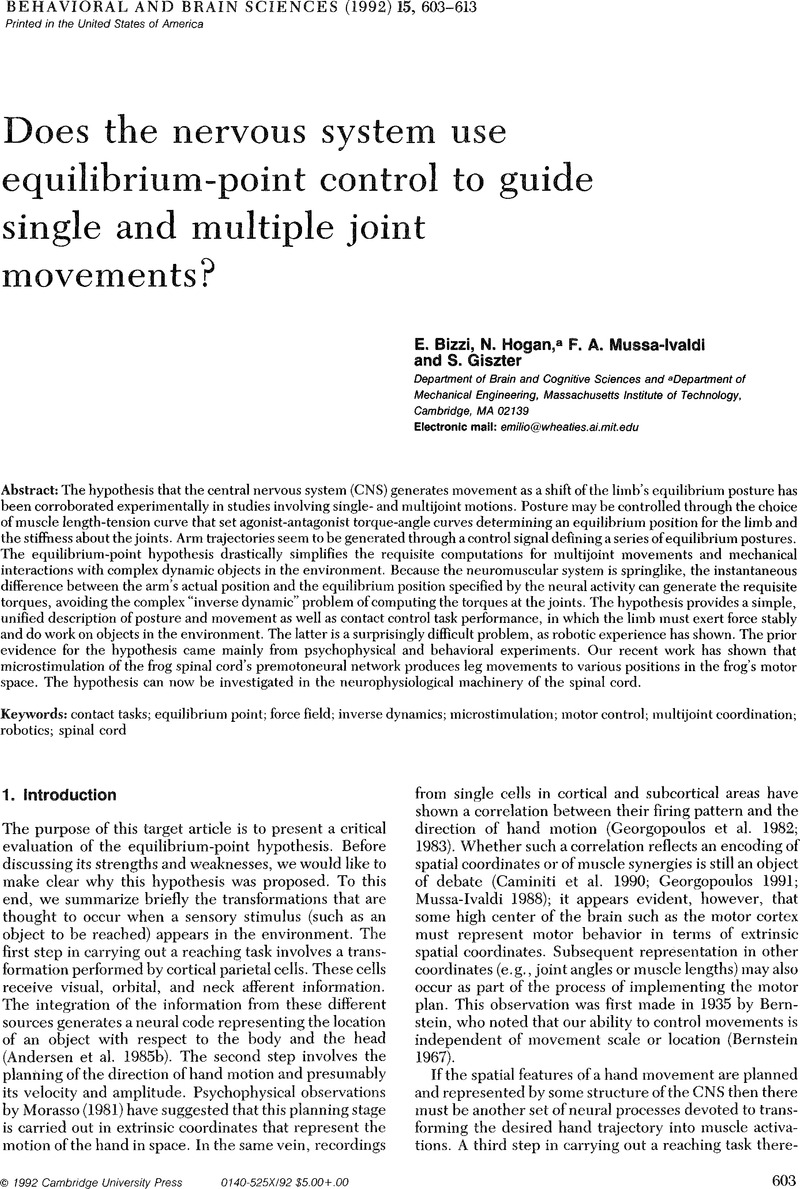Crossref Citations
This article has been cited by the following publications. This list is generated based on data provided by Crossref.
Latash, Mark L.
and
Zatsiorsky, Vladimir M.
1993.
Joint stiffness: Myth or reality?.
Human Movement Science,
Vol. 12,
Issue. 6,
p.
653.
Kay, Bruce A.
1995.
Frames of reference interact and are task-dependent.
Behavioral and Brain Sciences,
Vol. 18,
Issue. 4,
p.
765.
Scott, Stephen H.
1995.
Can the λ model be used to interpret the activity of single neurons?.
Behavioral and Brain Sciences,
Vol. 18,
Issue. 4,
p.
778.
Patla, Aftab E.
1995.
The λ model: Can it walk?.
Behavioral and Brain Sciences,
Vol. 18,
Issue. 4,
p.
775.
Hamm, Thomas M.
and
Han, Zong-Sheng
1995.
Is λ an appropriate control variable for locomotion?.
Behavioral and Brain Sciences,
Vol. 18,
Issue. 4,
p.
761.
Gottlieb, Gerald L.
1995.
Shifting frames of reference but the same old point of view.
Behavioral and Brain Sciences,
Vol. 18,
Issue. 4,
p.
758.
van Emmerik, R. E. A.
and
Wagenaar, R. C.
1995.
Equifinality and phase-resetting: The role of control parameter manipulations.
Behavioral and Brain Sciences,
Vol. 18,
Issue. 4,
p.
783.
Hatsopoulos, Nicholas G.
and
Warren, William H.
1995.
Do control variables exist?.
Behavioral and Brain Sciences,
Vol. 18,
Issue. 4,
p.
762.
Winters, Jack M.
1995.
How far should we extend the equilibrium point (lambda) hypothesis?.
Behavioral and Brain Sciences,
Vol. 18,
Issue. 4,
p.
785.
Flanagan, J. Randall
Tresilian, James R.
and
Wing, Alan M.
1995.
Grip force adjustments during rapid hand movements suggest that detailed movement kinematics are predicted.
Behavioral and Brain Sciences,
Vol. 18,
Issue. 4,
p.
753.
Morasso, Pietro
and
Sanguineti, Vittorio
1995.
Kinematic invariances and body schema.
Behavioral and Brain Sciences,
Vol. 18,
Issue. 4,
p.
769.
Latash, Mark L.
1995.
Equilibrium-point control? Yes! Deterministic mechanisms of control? No!.
Behavioral and Brain Sciences,
Vol. 18,
Issue. 4,
p.
765.
Pagano, Christopher C.
and
Bingham, Geoffrey P.
1995.
Spatial frames for motor control would be commensurate with spatial frames for vision and proprioception, but what about control of energy flows?.
Behavioral and Brain Sciences,
Vol. 18,
Issue. 4,
p.
773.
Bonnard, Mireille
and
Pailhous, Jean
1995.
A few reasons why psychologlsts can adhere to Feldman and Levin's model.
Behavioral and Brain Sciences,
Vol. 18,
Issue. 4,
p.
746.
Gielen, C. C. A. M.
and
van Bolhuis, B.
1995.
Reciprocal and coactivation commands are not sufficient to describe muscle activation patterns.
Behavioral and Brain Sciences,
Vol. 18,
Issue. 4,
p.
754.
Dean, Jeffrey
1995.
The lambda model is only one piece in the motor control puzzle.
Behavioral and Brain Sciences,
Vol. 18,
Issue. 4,
p.
749.
Goodman, Simon R.
1995.
Inverse kinematic problem: Solutions by pseudoinversion, inversion and no-inversion.
Behavioral and Brain Sciences,
Vol. 18,
Issue. 4,
p.
756.
McDonald, P. Vernon
1995.
Can the λ model benefit from understanding human adaptation in weightlessness(and vice versa)?.
Behavioral and Brain Sciences,
Vol. 18,
Issue. 4,
p.
768.
Feldman, Anatol G.
and
Levin, Mindy F.
1995.
The origin and use of positional frames of reference in motor control.
Behavioral and Brain Sciences,
Vol. 18,
Issue. 4,
p.
723.
Partridge, Lloyd D.
1995.
Let us accept a “controlled trade-off” model of motor control.
Behavioral and Brain Sciences,
Vol. 18,
Issue. 4,
p.
773.



